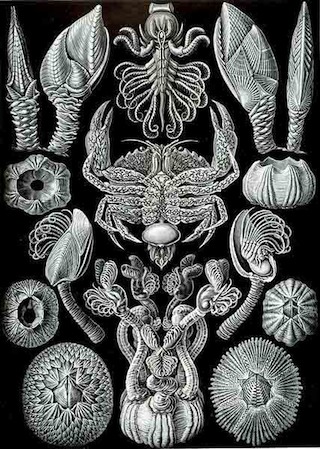
Cirripedia (incl. Barnacles)
Barnacles - are you crazy? Aren't those slugs in a shell?
It is worth a slight digression to examine how barnacles are in fact at all related to lobsters and prawns, given that their outward appearance on casual inspection is more like a snail and gives little indication of any appendages whatsoever!
In fact, hidden within the barnacle shell are all the bits and pieces which make it a proper member of Crustacea. It has two pairs of antennae (largely vestigial), but instead of reaching grandly forwards as the lobster, the barnacle conceals them by excreting a strong adhesive 'cement' from glands at the base of its first antennae pair - and affixing itself upside down by adhering its forehead to the base strata on which is lives (e.g. a ships hull or a whale's back).
Like other crustaceans, the barnacle's body consists of segments and chitinous plates, but in the barnacle they are largely (in some cases completely) fused together and present more evidently as the 'top' or back of the barnacle.
Inside of this fused carapace, the appendages of the barnacle face project upwards (remember the barnacle has glued itself by adhering its forehead to the humpback whale on which is is hitching a ride). It's six pairs of legs, rather unlike those of the lobster, are long and feathery and filter food from the water. You'll only see these feathery legs at all when the barnacle is undisturbed and actively feeding, however, which is why prying up a barnacle to inspect it give it the 'slug in a shell' appearance!